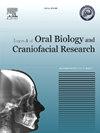Enhanced hierarchical attention networks for predictive interactome analysis of LncRNA and CircRNA in oral herpes virus
Q1 Medicine
Journal of oral biology and craniofacial research
Pub Date : 2025-03-10
DOI:10.1016/j.jobcr.2025.02.012
引用次数: 0
Abstract
Background
Non-coding RNAs, including lncRNAs, circRNAs, and microRNAs, constitute 98 % of the human transcriptome and are vital regulators of gene expression, cellular processes, and host-pathogen interactions, particularly in viral infections. This study explores lncRNA-circRNA interactions and their biological significance in oral viral infections.
Methods
ViRBase, a database with over 820,000 interactions involving 50,000 RNAs from 116 viruses and 36 host organisms, was used to analyze herpesvirus datasets. The study employed hierarchical attention and knowledge graph embeddings to represent nodes and edges in the knowledge graph. These served as input features for a hierarchical attention model trained over 100 epochs. Model performance was evaluated based on loss calculation, optimization, and attention weight stability.
Results
The model achieved a final loss of 0.000180 at Epoch 100, with stable attention weights confirming reliability. Node embedding statistics showed a mean of 0.005110 and a standard deviation of 0.013370, while attention weights had a high mean of 0.997178, emphasizing model robustness.
Conclusion
This study provides insights into lncRNA-circRNA interactions in herpes viral infections, enhancing therapeutic development, disease progression monitoring, and understanding host-pathogen interactions, paving the way for targeted interventions and improved outcomes.

用于预测口腔疱疹病毒LncRNA和CircRNA相互作用组分析的增强分层注意网络
非编码rna,包括lncrna、circrna和microrna,占人类转录组的98%,是基因表达、细胞过程和宿主-病原体相互作用的重要调节因子,特别是在病毒感染中。本研究探讨lncRNA-circRNA在口腔病毒感染中的相互作用及其生物学意义。方法使用svirbase数据库分析疱疹病毒数据集,该数据库包含来自116种病毒和36种宿主生物的50,000个rna,超过82万个相互作用。研究采用层次关注和知识图嵌入来表示知识图中的节点和边。这些作为输入特征,用于训练超过100次的分层注意模型。基于损失计算、优化和关注权重稳定性对模型性能进行评估。结果模型在Epoch 100时的最终损失为0.000180,注意权重稳定,证实了模型的可靠性。节点嵌入统计量均值为0.005110,标准差为0.013370,注意权值均值较高,为0.997178,强调了模型的稳健性。结论本研究揭示了lncRNA-circRNA在疱疹病毒感染中的相互作用,促进了治疗开发、疾病进展监测和理解宿主-病原体相互作用,为靶向干预和改善结果铺平了道路。
本文章由计算机程序翻译,如有差异,请以英文原文为准。
求助全文
约1分钟内获得全文
求助全文
来源期刊

Journal of oral biology and craniofacial research
Medicine-Otorhinolaryngology
CiteScore
4.90
自引率
0.00%
发文量
133
审稿时长
167 days
期刊介绍:
Journal of Oral Biology and Craniofacial Research (JOBCR)is the official journal of the Craniofacial Research Foundation (CRF). The journal aims to provide a common platform for both clinical and translational research and to promote interdisciplinary sciences in craniofacial region. JOBCR publishes content that includes diseases, injuries and defects in the head, neck, face, jaws and the hard and soft tissues of the mouth and jaws and face region; diagnosis and medical management of diseases specific to the orofacial tissues and of oral manifestations of systemic diseases; studies on identifying populations at risk of oral disease or in need of specific care, and comparing regional, environmental, social, and access similarities and differences in dental care between populations; diseases of the mouth and related structures like salivary glands, temporomandibular joints, facial muscles and perioral skin; biomedical engineering, tissue engineering and stem cells. The journal publishes reviews, commentaries, peer-reviewed original research articles, short communication, and case reports.
 求助内容:
求助内容: 应助结果提醒方式:
应助结果提醒方式:


